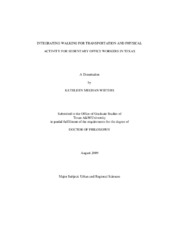| dc.description.abstract | The workplace is considered a strategic location for health promotion. According to the Texas Workforce Commission, office workers represent up to 40% of the workforce in Texas and the general nature of the type of work is sedentary. Additional study is needed on how the built environment near the worksite area impacts walking behaviors and to determine interventions effective in increasing walking as part of daily routines among office workers.
The two aims of this dissertation were: 1) investigate the differences that urban and suburban settings may have on walking behavior (walk trips, walk duration, total step count) of office workers in Texas and 2) to examine the impact of a simple intervention in increasing walking within the respective land use settings. This study utilized on-line survey and travel diary, pedometer, and Geographic Information System to capture the study variables, which included personal, social and cultural, organizational, and built environmental factors.
Results showed that urban office workers walk, on average, 600 steps more per day than the suburban office workers. Office workers in both land use settings on average have not met the recommended level of walking steps per day of 10,000 steps per day (Urban Mean=4,932 steps per day, Suburban Mean=4,347 steps per day). Post-intervention step count averaged 5,734 steps per day for urban office workers in contrast to 4,257 steps per day for suburban office workers. This translated to a 16% increase and 2% decrease in walking steps for urban and suburban office workers, respectively.
The built environment in terms of land use setting, urban versus suburban, and availability of land use destinations showed associations with walking behavior for office workers. Destinations positively associated with the number of walking trips, including access to bookstores and coffee shops. Access to convenience stores and food establishments for suburban office workers were more relevant for walking duration. Significant destinations for the urban office workers' walking duration per week included the number of banks and food establishments within one fourth mile from their office building.
The results for the second aim, testing the tailored information intervention, were informative, though not significant. The intervention did not yield a significant change in walking step count, but provided insight on opportunities for future studies. | en |


